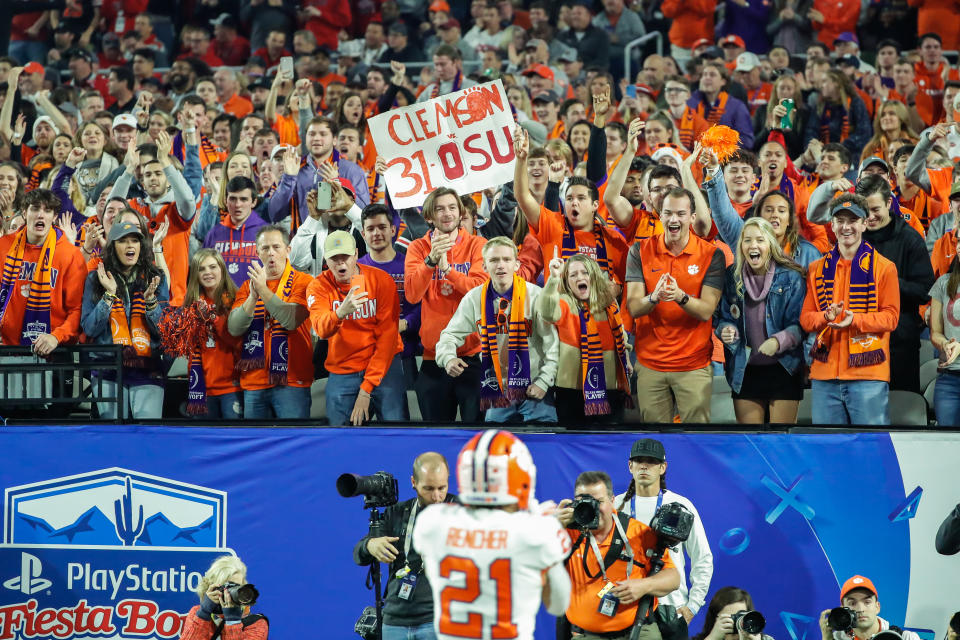Here's the biggest factor in college football returning this fall

The biggest question looming over the collegiate athletics landscape is a simple one: “Will there be football in the fall?”
College football is the top financial engine of the multi-billion dollar college athletics industry. It also projects as a vital part of the collective American psyche, as the familiar rhythm of football on Saturdays provides a heartbeat to the fall in college towns around the country.
The potential start of the season is nearly five months away, with teams scheduled to begin reporting for training camps in four months.
For those looking for signs of the return of college football, the most important decision dictating that decision appears to be the return of students to actual colleges. All these micro decisions, of course, are predicated on important real-life factors tied to containing the spread of the coronavirus, the impact of social distancing and the emergence of some type of vaccine.
But for those looking for hints of hope for college football’s return, they should start with the clearance for students to return to campus. Yahoo Sports reached out to a dozen athletic directors and administrators on Wednesday about the potential return of football this fall. Most pointed to the return of students to campus as a key harbinger.
“With school not in session, I don’t believe it is practical or proper to have intercollegiate athletics,” Clemson athletic director Dan Radakovich said. “Much like we are experiencing on campus right now.”
Notre Dame athletic director Jack Swarbrick predicted a “cascading of decisions” that will portend whether or not we see college football in the fall. He said that one of those has already happened at Notre Dame with the cancellation of commencement.
The next “mile markers,” according to Swarbrick, are if there will be summer school on campus and then whether or not there will be athletic and academic summer camps on campus. (Ohio State, for example, already moved in-person summer school classes to online this week.) “These will come in a logical sequence and help inform the next one,” he said.
Of all the major American sports, both collegiate and professional, college football presents some of the most vexing complications. There’s no “quarantine in Vegas” like what’s being bandied around the NBA.
And Swarbrick points out the mixed messages of telling students to stay home and athletes to come to campus if the conditions don’t abate.
“It’d be very hard to do,” Swarbrick said. “There’s a liability. Some of the dynamics of the game being what they are. The nature of it is such that there’s significant risks.”
It’s hard to envision any return to campus if testing for the coronavirus does not become exponentially more widely available. This is especially applicable in football, which is a contact sport and both practices and the locker room settings loom as places where the virus could spread quickly.
The general college campus is another one of those places. The controversial return of students to Liberty University and the unfolding issues this week provided a reminder of all the factors on a college campus that are antithetical to social distancing. From people traveling from all over the world to living in close quarters to the inherent social interactions, the college campus is a place rife with situations where the virus could spread.
While much of the money from college football comes from television revenue, there’s still significant ticket revenue that can reach as much as $50 million annually for top programs. Losing that revenue wouldn’t be appealing, as the opportunity to delay the sport to the second semester and playing then would be more appealing to programs than playing in empty stadiums.
There’s also little chance from a liability perspective that schools would invite tens of thousands of fans to crowd into a stadium when they’ve deemed it unsafe for the regular student population to return. The notions of large crowds on campuses seems far away.
Big 12 commissioner Bob Bowlsby delivered a clear answer when asked if games could be played in the fall without students on campus. “No,” he said. “The participants are students.”
The hope prevailing around the landscape, of course, is that this type of talk is premature. Perhaps what we remember as normal life replaces this scary new normal. That would certainly be best for the budgets and well-being of college leaders around the country. “I think we will try everything possible to have a season,” West Virginia president Gordon Gee said. “College football may be the psychological antidote to the virus.”
It will be months until decisions on both campus and athletics are made. Until that time, athletic departments are soldiering ahead and hoping for the best.
“We are planning on having a college football season this coming fall,” Alabama athletic director Greg Byrne said. “And we will adjust if and when it’s appropriate.”
And those adjustments project to be guided by decisions made on campus, as the future of college football will be just as focused on the college aspect as the football part.
“Nothing quite matches the unique issues that are created by the activity being integrated into an academic institution,” Swarbrick said. “There’s nothing like it in other sports.”
More from Yahoo Sports:

 Yahoo News
Yahoo News 